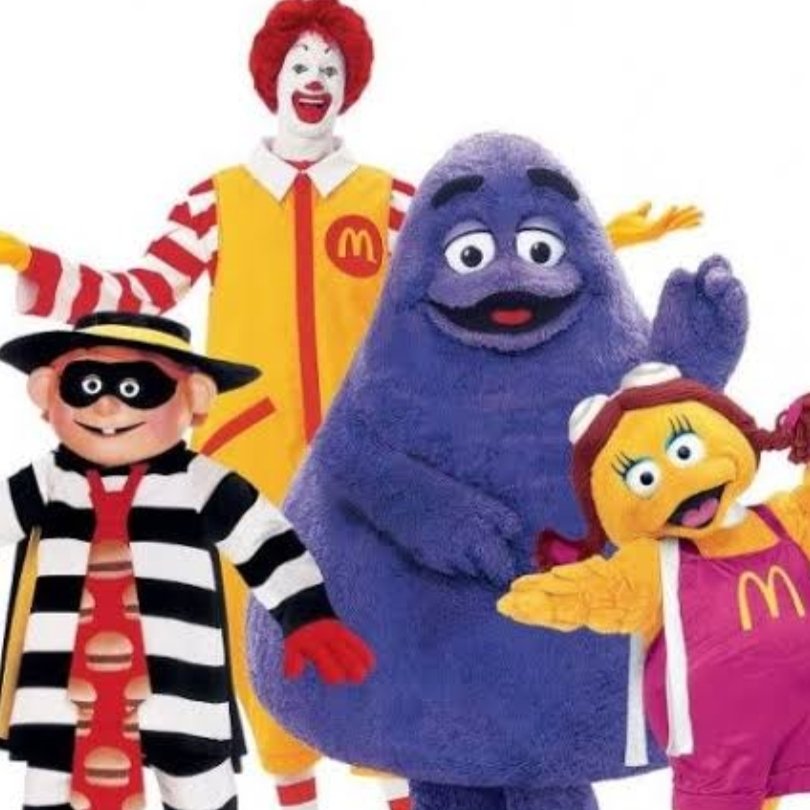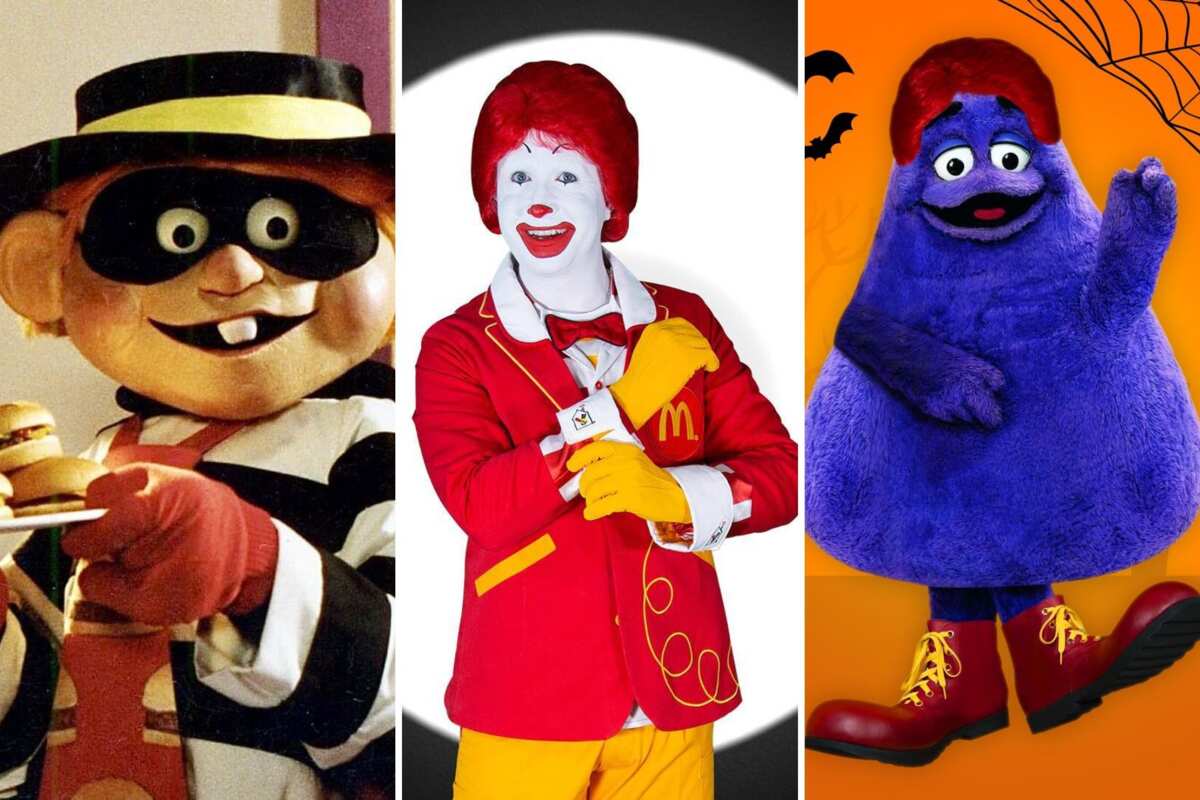Ever wondered who those colorful characters hanging around McDonald's really are? They're not just random cartoons—they're icons with a story that dates back decades. McDonald's characters have been part of our childhood memories, appearing in ads, toys, and even fast-food packaging. Today, we're diving deep into the world of these beloved mascots and uncovering the secrets behind their creation.
From the iconic Ronald McDonald to the lesser-known Hamburglar, these characters have shaped the fast-food giant's identity. But what makes them so special? Why do they resonate with people across generations? Let's explore the history, evolution, and impact of McDonald's characters on pop culture.
Whether you're a fan of the classic mascots or curious about how they've evolved over the years, this article has got you covered. We'll uncover the stories behind each character, their significance, and how they've contributed to the McDonald's brand. So grab a Big Mac and let's get started!
Read also:Who Is Drake Dating The Latest On His Love Life And Relationships
Table of Contents
- The History of McDonald's Characters
- Ronald McDonald: The Face of McDonald's
- The Hamburglar: Stealing Hearts, Not Just Burgers
- French Fry Guy and Other Forgotten Icons
- The Design Evolution of McDonald's Characters
- The Role of Characters in Marketing
- Popularity and Cultural Impact
- Criticism and Controversy
- The Future of McDonald's Characters
- Wrapping It Up
The History of McDonald's Characters
Let's rewind to the early days of McDonald's. Back in the 1960s, the fast-food giant was looking for ways to connect with kids and families. That's when they decided to create mascots that would represent their brand. It wasn't just about selling burgers—it was about building a community around the McDonald's experience.
Fast forward to today, and McDonald's characters have become cultural icons. But it wasn't always smooth sailing. Over the years, these mascots have faced criticism, rebranding, and even retirement. Yet, they've managed to stay relevant, adapting to changing times and audiences.
Why Characters Matter in Branding
Characters play a crucial role in branding, especially for companies targeting families and kids. They create an emotional connection, making the brand more relatable and memorable. For McDonald's, characters like Ronald McDonald and the Hamburglar became synonymous with fun, happiness, and good times.
Studies show that mascots can boost brand recognition by up to 30%. This is why McDonald's invested heavily in character development, ensuring they resonated with their target audience. And let's not forget, these characters weren't just for show—they had personalities, backstories, and even catchphrases that made them stand out.
Ronald McDonald: The Face of McDonald's
Let's talk about the big guy himself—Ronald McDonald. Introduced in 1963, Ronald quickly became the face of McDonald's. With his bright red hair, oversized shoes, and cheerful demeanor, he was the ultimate ambassador for the brand. But did you know Ronald wasn't always a clown?
Initially, McDonald's considered several mascot ideas, including a chef and even a cowboy. But the clown concept won over, thanks to its playful and approachable nature. Over the years, Ronald has undergone several transformations, from his classic clown look to a more polished, modern appearance.
Read also:Ellen Pompeos Husband The Love Story Behind The Screen
Ronald's Impact on McDonald's Success
There's no denying Ronald's impact on McDonald's success. He became a household name, appearing in countless ads, TV shows, and even movies. His catchphrase, "I'm lovin' it," became a global slogan, further cementing his place in pop culture.
However, Ronald's journey hasn't been without challenges. In recent years, there's been a push to retire the clown character due to changing perceptions of clowns in society. Despite this, Ronald remains a beloved figure for many, reminding us of simpler times and happy meals.
The Hamburglar: Stealing Hearts, Not Just Burgers
Who could forget the Hamburglar? With his mischievous grin and signature catchphrase, "I'm lovin' it," the Hamburglar became one of McDonald's most iconic characters. Introduced in 1971, this little thief quickly captured the hearts of kids and adults alike.
But the Hamburglar wasn't just about stealing burgers—he represented the fun and excitement of McDonald's. His antics brought humor and energy to the brand, making him a fan favorite for decades. And let's not forget his classic look—black mask, red coat, and a big appetite for burgers.
Evolution of the Hamburglar
Like Ronald, the Hamburglar has undergone several changes over the years. From his classic cartoon look to a more modern, animated version, the character has adapted to keep up with the times. In recent years, McDonald's even brought back the Hamburglar for a limited-time campaign, proving that nostalgia is a powerful marketing tool.
Fun fact: The Hamburglar was originally voiced by veteran actor Jim Backus, best known for his role as Thurston Howell III in "Gilligan's Island." This added a layer of authenticity and charm to the character, making him even more memorable.
French Fry Guy and Other Forgotten Icons
While Ronald and the Hamburglar get all the attention, there were other McDonald's characters that deserve a shoutout. Take French Fry Guy, for example. Introduced in the 1980s, this quirky character was all about fries—serving them up with a smile and a side of fun.
Then there's the Mac and Mac Jr., two burger-loving brothers who represented McDonald's signature sandwiches. These characters might not have had the same staying power as Ronald and the Hamburglar, but they played an important role in the brand's early years.
Why Some Characters Faded Away
Not all McDonald's characters stood the test of time. Some, like French Fry Guy and Mac and Mac Jr., faded into obscurity as the brand evolved. But why? It often came down to changing marketing strategies and shifting consumer preferences. As McDonald's focused more on global campaigns, some characters simply didn't fit the new narrative.
That said, these forgotten icons still hold a special place in the hearts of those who grew up with them. They remind us of a time when McDonald's was all about fun and creativity, before the brand became the global powerhouse it is today.
The Design Evolution of McDonald's Characters
Design plays a huge role in the success of any character. For McDonald's, this meant creating mascots that were both visually appealing and aligned with the brand's values. Over the years, the design of McDonald's characters has evolved significantly, reflecting changes in technology, culture, and consumer preferences.
In the early days, characters like Ronald and the Hamburglar were simple, hand-drawn illustrations. As technology advanced, these characters transitioned to 2D and 3D animations, bringing them to life in new and exciting ways. Today, McDonald's characters are designed with a mix of nostalgia and modernity, appealing to both old fans and new audiences.
Key Design Elements
- Bright colors to capture attention
- Simple shapes for easy recognition
- Playful expressions to convey fun and happiness
- Consistent branding elements, like the golden arches
These design elements ensure that McDonald's characters remain instantly recognizable, no matter where you are in the world.
The Role of Characters in Marketing
Marketing is all about storytelling, and McDonald's characters have been instrumental in telling the brand's story. From TV ads to social media campaigns, these mascots have helped McDonald's connect with audiences on a personal level. But how exactly do characters fit into the marketing mix?
For starters, characters create an emotional connection with consumers. They humanize the brand, making it more relatable and approachable. They also serve as a bridge between the brand and its audience, helping to communicate key messages in a fun and engaging way.
Successful Campaigns Featuring Characters
Some of McDonald's most successful campaigns have featured their iconic characters. Take the "I'm Lovin' It" campaign, for example. This global initiative used Ronald McDonald and the Hamburglar to promote the brand's signature products, creating a sense of unity and excitement around the world.
Another standout campaign was the "Our Food, Your Questions" initiative, where McDonald's used characters to address common concerns about their food. This approach not only educated consumers but also built trust and transparency, two crucial elements in today's competitive market.
Popularity and Cultural Impact
McDonald's characters have had a significant impact on pop culture, influencing everything from fashion to entertainment. Their widespread popularity can be attributed to their relatability, charm, and ability to adapt to changing times. But what exactly makes these characters so special?
For one, they represent the essence of McDonald's—fun, family, and good food. They've become part of the fabric of our lives, appearing in everything from birthday parties to TV shows. And let's not forget their influence on merchandise, from toys to clothing, further cementing their place in popular culture.
Global Appeal of McDonald's Characters
While McDonald's characters were originally created for the U.S. market, they've since gained global appeal. This is thanks in part to McDonald's commitment to localization, adapting their characters to fit different cultures and preferences. For example, in some countries, Ronald McDonald is portrayed as a magician or superhero, reflecting local traditions and values.
This global reach has allowed McDonald's characters to resonate with audiences worldwide, proving that good storytelling transcends borders and languages.
Criticism and Controversy
No story is complete without a little drama, and McDonald's characters have faced their fair share of criticism over the years. From concerns about the use of clowns in marketing to accusations of promoting unhealthy eating habits, these mascots have been at the center of some heated debates.
One of the biggest controversies surrounding McDonald's characters is their association with childhood obesity. Critics argue that using fun and playful mascots to promote fast food sends the wrong message to kids. In response, McDonald's has made efforts to promote healthier options and reduce the emphasis on sugary treats in their marketing.
Addressing Criticism
McDonald's has taken steps to address these concerns, including retiring some characters and revamping others. For example, Ronald McDonald has been reimagined as a more modern, health-conscious ambassador for the brand. This shift reflects a broader trend in the food industry, where companies are increasingly prioritizing health and wellness in their marketing strategies.
That said, the debate over the role of mascots in advertising continues, highlighting the need for balance and responsibility in marketing to kids.
The Future of McDonald's Characters
So, what does the future hold for McDonald's characters? As the brand continues to evolve, it's likely we'll see new characters emerge, alongside updates to existing ones. With the rise of digital media and social platforms, McDonald's has an opportunity to reinvent its mascots for a new generation.
We might also see a greater emphasis on diversity and inclusion, as McDonald's looks to connect with audiences from all walks of life. This could mean introducing characters that reflect different cultures, backgrounds, and experiences, further enriching the brand's storytelling.
Predictions for McDonald's Characters
- More focus on digital and animated content
- Incorporation of augmented reality (AR) and virtual reality (VR) experiences
- Expansion of merchandise and collectibles featuring characters
- Collaborations with influencers and content creators
These trends suggest that McDonald's characters will continue to play a vital role in the brand's future, adapting to new technologies and consumer preferences while staying true to their roots.
Wrapping It Up
From Ronald McDonald to the Hamburglar, McDonald's characters have been a cornerstone of the brand's identity for decades. They've brought joy, laughter, and nostalgia to millions of people around the world, becoming an integral part of pop culture. But as the fast-food industry continues to evolve, so too must these beloved mascots.
As we look to the future, it's clear that McDonald's characters will remain a powerful tool in the brand's marketing arsenal. Whether through new designs, digital innovations, or collaborations with influencers, these icons will continue to captivate and


